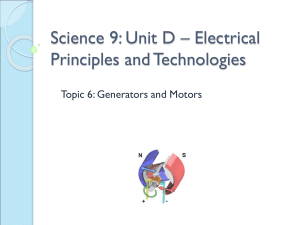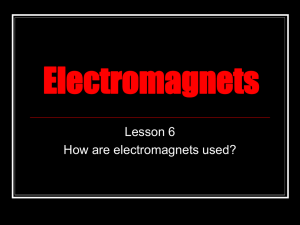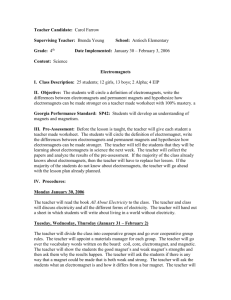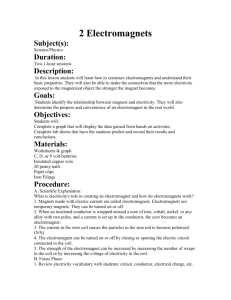6-5.3 - S2TEM Centers SC
advertisement
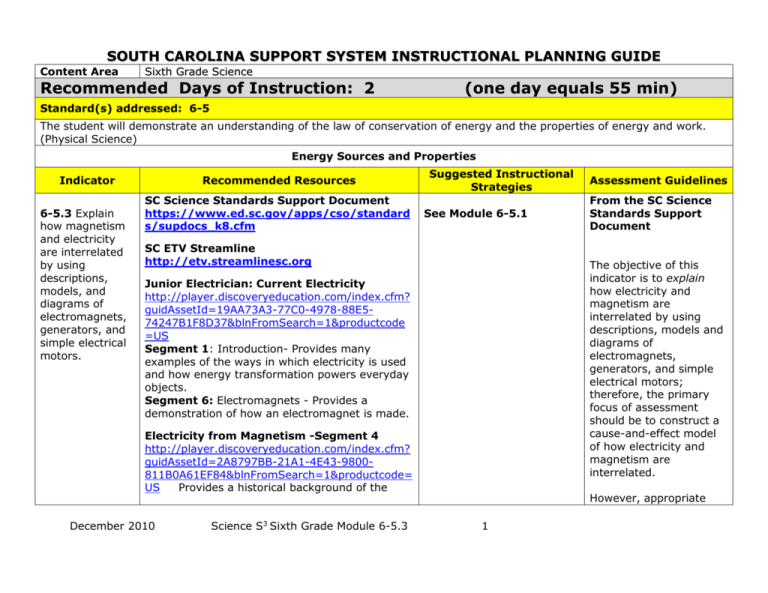
SOUTH CAROLINA SUPPORT SYSTEM INSTRUCTIONAL PLANNING GUIDE Content Area Sixth Grade Science Recommended Days of Instruction: 2 (one day equals 55 min) Standard(s) addressed: 6-5 The student will demonstrate an understanding of the law of conservation of energy and the properties of energy and work. (Physical Science) Energy Sources and Properties Indicator 6-5.3 Explain how magnetism and electricity are interrelated by using descriptions, models, and diagrams of electromagnets, generators, and simple electrical motors. Recommended Resources SC Science Standards Support Document https://www.ed.sc.gov/apps/cso/standard s/supdocs_k8.cfm Suggested Instructional Strategies See Module 6-5.1 SC ETV Streamline http://etv.streamlinesc.org Electricity from Magnetism -Segment 4 http://player.discoveryeducation.com/index.cfm? guidAssetId=2A8797BB-21A1-4E43-9800811B0A61EF84&blnFromSearch=1&productcode= US Provides a historical background of the Science S3 Sixth Grade Module 6-5.3 From the SC Science Standards Support Document The objective of this indicator is to explain how electricity and magnetism are interrelated by using descriptions, models and diagrams of electromagnets, generators, and simple electrical motors; therefore, the primary focus of assessment should be to construct a cause-and-effect model of how electricity and magnetism are interrelated. Junior Electrician: Current Electricity http://player.discoveryeducation.com/index.cfm? guidAssetId=19AA73A3-77C0-4978-88E574247B1F8D37&blnFromSearch=1&productcode =US Segment 1: Introduction- Provides many examples of the ways in which electricity is used and how energy transformation powers everyday objects. Segment 6: Electromagnets - Provides a demonstration of how an electromagnet is made. December 2010 Assessment Guidelines However, appropriate 1 discovery of electricity from magnets, Also shows how electricity can be created from magnetism and the applications of this process. assessments should also require students to interpret diagrams of electromagnets, generators, or electric motors showing how electricity and magnetism are interrelated; summarize information about how electricity and magnetism are interrelated using diagrams, models, and descriptions of devices; compare devices based on how they interrelate electricity and magnetism; or recognize devices based on their functions. Getting to Know Electricity Segment 8: Electromagnetism and Segment 9: Generators http://player.discoveryeducation.com/index.cfm? guidAssetId=B457EC25-AD81-4C8C-B1530F10253EC2E9&blnFromSearch=1&productcode= US Shows the relationship between electricity and magnetism to create electromagnets and Benjamin Franklin explains how generators work to produce electricity. Electricity & Magnetism: Magic of Magnets Segment 3: Electromagnets http://player.discoveryeducation.com/index.cfm? guidAssetId=6E4A4FFF-3D1E-49CB-8E50C7F28DB244FB&blnFromSearch=1&productcode =US Describes the discovery of electromagnets and how electromagnets are made. The science behind electromagnets is also examined American Association for the Advancement of Science http://www.kineticcity.com/controlcar/activity.ph p?virus=enervia&act=4 Different kinds of energy have different advantages. Some are cheap, some are safer for the environment, and some are very efficient. Usually, though, you can’t get all three. In this game, your job is to provide power for a gigantic city. But you need to do it without running out of money or ruining the environment. December 2010 Science S3 Sixth Grade Module 6-5.3 2 Indicator Module 6-5.3 Continued Suggested Instructional Recommended Resources Strategies California Energy Commission http://www.energyquest.ca.gov/ This website provides numerous resources about types of energy and energy conservation. It includes teacher and parent resources, puzzles, games and energy stories. http://edtech.kennesaw.edu/web/electric.html This site contains several links to a variety of websites about electricity. It also includes activities and lesson plans. December 2010 Science S3 Sixth Grade Module 6-5.3 3 Assessment Guidelines Sixth Grade Science Module 6-5.3 Conservation of Energy Lesson A Standard 6-5: The student will demonstrate an understanding of the law of conservation of energy and the properties of energy and work. (Physical Science) Indicator 6-5.3: Explain how magnetism and electricity are interrelated by using descriptions, models, and diagrams of electromagnets, generators, and simple electrical motors. December 2010 Science S3 Sixth Grade Module 6-5.3 4 From the South Carolina Science Support Document: Indicator 6-5.3: Explain how magnetism and electricity are interrelated by using descriptions, models, and diagrams of electromagnets, generators, and simple electrical motors. Taxonomy level of indicator: Understand Conceptual Knowledge (2.7-B) Previous/Future Knowledge: In 4th grade (4-5.9), students summarized the properties of magnets and electromagnets (including polarity, attraction/repulsion, and strength). Students have not been introduced the concept of generators and simple electrical motors in previous grade levels. Students will further develop the concepts of electromagnets, generators, and simple electrical motors in high school physical science (PS-6-11). It is essential for students to know that magnetism is the force of attraction or repulsion of magnetic materials. Surrounding a magnet is a magnetic field that applies a force, a push or pull, without actually touching an object. An electric current flowing through a wire wrapped around an iron core forms a magnet. A coil of wire spinning around a magnet or a magnet spinning around a coil of wire can form an electric current. Examples of how magnetism and electricity are interrelated can be demonstrated by the following devices: Electromagnets An electromagnet is formed when a wire in an electric circuit is wrapped around an iron core producing a magnetic field. The magnet that results loses its magnetism if the electric current stops flowing. Generators A generator produces an electric current when a coil of wire wrapped around an iron core is rotated near a magnet. Generators at power plants produce electric energy for our homes. A generator contains coils of wire that are stationary, and rotating magnets are rotated by turbines. Turbines are huge wheels that rotate when pushed by water, wind, or steam. Thus mechanical energy is changed to electrical energy by a generator. Smaller generators may be powered by gasoline. December 2010 Science S3 Sixth Grade Module 6-5.3 5 Simple electric motors An electric motor changes electrical energy to mechanical energy. It contains an electromagnet that rotates between the poles of a magnet. The coil of the electromagnet is connected to a battery or other source of electric current. When an electric current flows through the wire in the electromagnet, a magnetic field is produced in the coil. Like poles of the magnets repel and unlike poles of the magnets attract. This causes the coil to rotate and thus changes electrical energy to mechanical energy. This rotating coil of wire can be attached to a shaft and a blade in an electric fan. It is not essential for students to know components of generators or motors, the difference between AC and DC generators, or the function of a transformer. Understanding of how a magnetic field is produced is also not essential. Assessment Guidelines: The objective of this indicator is to explain how electricity and magnetism are interrelated by using descriptions, models and diagrams of electromagnets, generators, and simple electrical motors; therefore, the primary focus of assessment should be to construct a cause-and-effect model of how electricity and magnetism are interrelated. However, appropriate assessments should also require students to interpret diagrams of electromagnets, generators, or electric motors showing how electricity and magnetism are interrelated; summarize information about how electricity and magnetism are interrelated using diagrams, models, and descriptions of devices; compare devices based on how they interrelate electricity and magnetism; or recognize devices based on their functions. December 2010 Science S3 Sixth Grade Module 6-5.3 6 Teaching Indicator 6-5.3: Together” Lesson A– “How Electricity and Magnets Work Instructional Considerations: This lesson is an example of how a teacher might address the intent of this indicator. The Science and Technology for Children kit Magnets and Motors provides an opportunity for conceptual development of the concepts within the standard. In fourth grade, students studied electricity and magnetism. In this indicator, they will explore the relationship between electricity and magnetism by making and testing an electromagnet, a simple motor, and watching a generator work. Preparation for the Lesson: Obtain materials for electromagnet Make arrangements to use the SC Streamline videos Misconceptions: Students do not readily recognize the magnetic effect of an electric current. Some think of the wire, rather than the electric current as being the cause of the magnetic effect. Students may think that insulation around the wire prevents the existence of magnetic forces when current flows. http://strandmaps.nsdl.org/?id=SMS-MAP-2085 Safety Note: Remind students not to use magnets around or close to computers, televisions, cell phones, etc. Students should wear safety glasses during these activities. File the end of the nails prior to student use. Lesson time: 2 Days (1 day equals 55 minutes) Materials Needed: (per group) Magnets Iron coils (nails can be used) Wire Batteries (D Cell) Paper clips SC Streamline Video: “Getting to Know Electricity - Generators, SC Streamline Video: Electricity and Magnetism: Magic of Magnets, Segment 3: Electromagnets Focus Question: How are magnetism and electricity interrelated? Engage: 1. Have students use their notebooks and respond to the prompt: How are magnets and electricity interrelated? (will allow teacher to know what they remember from study of electricity and magnetism at 4th grade) 2. Allow a few students to share. December 2010 Science S3 Sixth Grade Module 6-5.3 7 3. Review magnetic fields by providing 2 magnets for each student. Ask them to apply a force without touching the magnets together. 4. Have them share what they did to apply the force and the results. 5. They should feel and describe the force of attraction and repulsion between the magnets. 6. Tell them that this lesson will explore further the relationships between electricity and magnetism as they make and test an electromagnet, explore a simple motor and watch a generator work Explore: 1. Ask students to use their notebooks and write all they know about electromagnets. Have them include an illustration. If prompt is needed, show them the magnet, wire and nail and battery and remind them that they studied electromagnets in 4th grade. 2. Provide materials for student cooperative groups to build an electromagnet. You might want to use the SC Streamline Video Electricity and Magnetism: Magic of Magnets, Segment 3: for review. 3. Ask them to design and carry out an investigation to determine what makes an electromagnet more effective. Provide them with paperclips to use with their electromagnet. 4. Ask students to use their electromagnet to pick up paperclips and record the number of clips picked up in relation to the number of coils of wire. 5. They should collect their data and organize it into a chart to use as evidence for their conclusion. 6. Have students summarize their investigation by completing the following statement: An electromagnet picks up __#__paperclips with _#___ coils of wire and __#___paperclips with __#___coils of wire. The (larger/smaller) the number of coils, the (stronger/weaker) the magnet. 7. Ask them to predict what would happen if they removed the wire from the battery? Have them try it and record the results. (Nail loses magnetism and no long picks up any paperclips) 8. Ask the students to give an explanation for their observations. 9. Have them summarize the investigation with a cause- and- effect statement. Ask them to use evidence from their investigation in their statement. 10.“When we had the battery, wire and nail all connected the electromagnet picked up paperclips. When we unconnected the battery the electromagnet did not pick up any paper clips because there was no electricity running through the system.” 11.Tell the students that generators and electric motors are two devices that are similar because they use electromagnets to produce power. 12.Use the SC Streamline Video: “Getting to Know Electricity: Generators” to allow students to understand how a generator works. 13.As they view the video, ask them to listen for confirmation that the generator contains an electromagnet. Tell them that electric motors provide power for all types of machinery. The electric motor is essentially an electromagnet that rotates within a stationary magnet. December 2010 Science S3 Sixth Grade Module 6-5.3 8 14. Purchase motors at Radio Shack or use the ones provided in Magnets and Motors if that kit is available. 15.Provide a motor and steel nail for each cooperative group and have them disassemble the motor. 16.Have students carefully use the nail to bend the metal tabs away from the plastic end of the motor. 17.Holding the motor case with one hand, ask students to push on the motor shaft with one finger allowing the plastic cap to come off. 18. Take the motor shaft out of the case. 19. Observe the parts of the motor. Locate the electromagnet, and the magnets. 20.Ask students to make a drawing of the motor labeling its parts. 21.Provide them with a list of appliances and have them research the use of electromagnets in each. (electric saw, toaster, clothes dryer, television, electric screwdriver, car, cell phones) Explain: 1. Show pictures of an electromagnet. Ask students to identify the various parts and describe how it works. See support document. 2. Discuss their observations of the motor. What did they find? Where was the electromagnet? How is an electromagnetic important to a motor? An electric motor changes electrical energy into mechanical energy. The motor contains the electromagnet that rotates between the poles of a magnet. In a battery powered appliance, the coil of the electromagnet is connected to a battery and when the current flows through the wire a magnetic field is produced in the coil. In a fan, this rotating coil of wire can be connected to the shaft or blade. These small motors are used to turn wheels in most remote control toy cars. Students may want to take an old one apart to find the motor. 3. Ask students to name examples of generators. (Often during power outages home owners turn to small generators powered by gasoline for power.) Show pictures of small home generators or turbines used in power plants. These turbines (or huge wheels) rotate the magnets. 4. Ask students to summarize the relationships between electromagnets and motors and generators. (transforms mechanical energy into electrical energy by producing an electric current when a coil of wire wrapped around an iron core is rotated near a magnet.) Extend: 1. Students can build a simple electric motor by following the directions on this website: http://www.evilmadscientist.com/article.php/HomopolarMotor 2. Instructions for making a small generator a. http://www.ehow.com/how_5782835_build-smallelectromagnetic-generators.html 3. http://amasci.com/amateur/coilgen.html Shows a video of building a simple generator from cardboard, wire, batteries and light bulb December 2010 Science S3 Sixth Grade Module 6-5.3 9 Pictures of Electromagnets December 2010 Science S3 Sixth Grade Module 6-5.3 10

